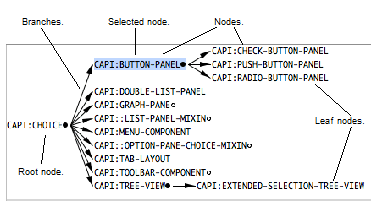






An example graph is shown in Example graph pane below. All graphs are laid out by the LispWorks IDE, so that their elements are displayed in an intuitive and easily visible hierarchy. A graph consists of a number of nodes , linked together by branches . By default, graphs in the environment are plotted from left to right: for any given node, the node to which it is linked on the left is known as its parent , and the nodes to which it is linked on the right are known as its children . The originating node of the graph (on the far left) is referred to as the root node , and the outermost nodes of the graph (towards the right) are referred to as leaf nodes . The root node does not have a parent, and leaf nodes do not have any children.


You can select nodes in a graph pane in exactly the same way that you select items in a list. Selected nodes are highlighted, as shown in Example graph pane.
Similarly, you can copy nodes from a graph onto the clipboard in a manner consistent with use of the clipboard in the rest of the environment. When you copy any selected node onto the clipboard, the Lisp object itself is copied onto the clipboard, so that it can be transferred into other tools in the LispWorks IDE.
LispWorks IDE User Guide (Windows version) - 13 Sep 2017